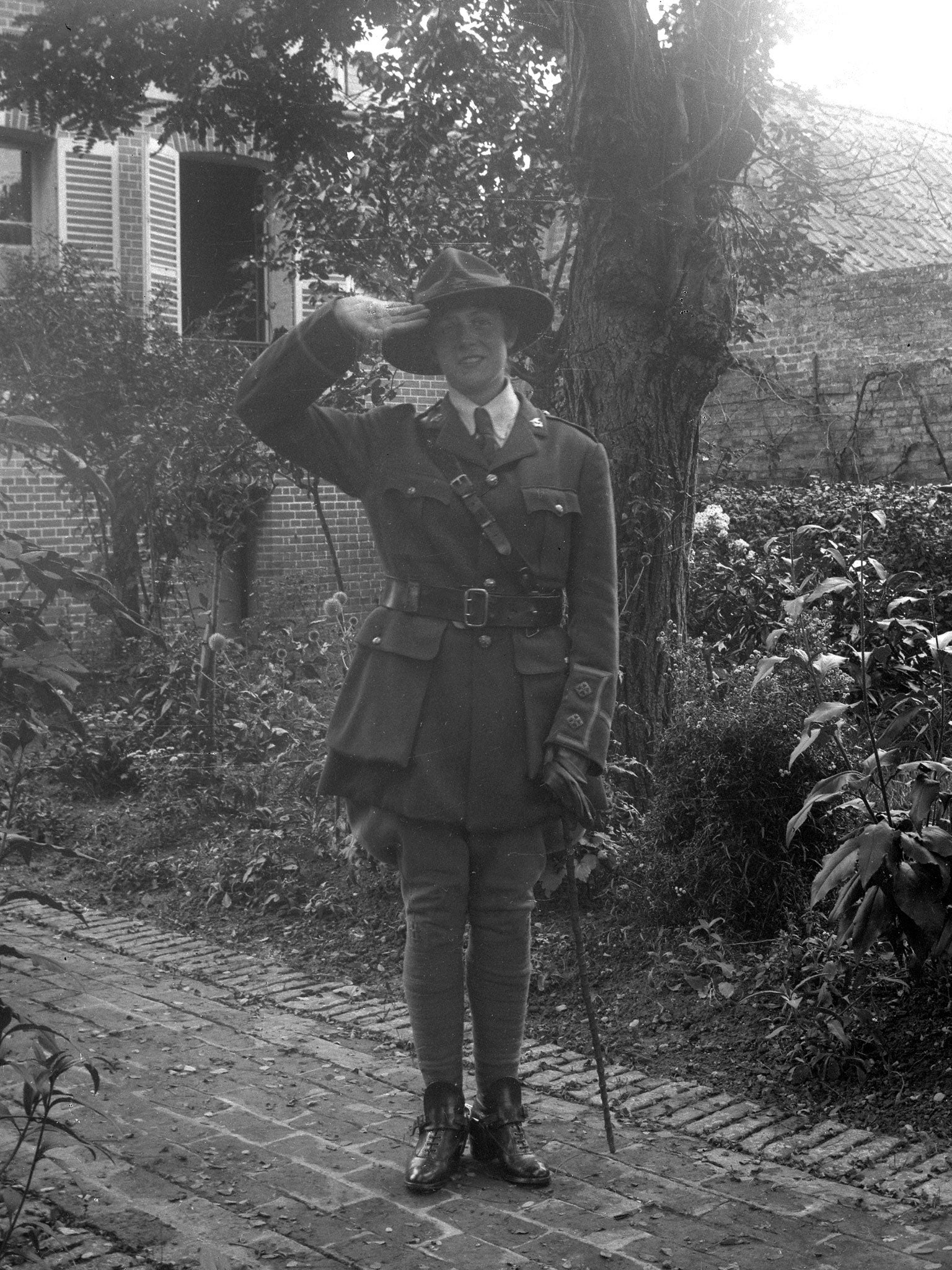Revealed: The story behind playful images of a First World War love affair and the mystery of 'man' in the lemon-squeezer hat
These Great War photos captivated IoS readers – now their poignant background can be disclosed
The playful images of a First World War love affair, discovered in northern France, generated interest around the globe. The photographs showed two “officers” in New Zealand uniforms in a sun-lit garden in the Somme. Closer inspection revealed that one of the “officers” was a young French woman who had “cross-dressed” by putting on a New Zealand uniform and a pointed, “lemon-squeezer” hat.
The pictures were something of a mystery when published in July. The Independent on Sunday has now traced the story of the couple – young people from opposite ends of the earth, brought together by the horrendous conflict that started 100 years ago next year.
They are Lieutenant Alic Boeufvé of the Otago Mounted Rifles and Marguerite Lefèvre, who was born in Paris in 1897 and died in 1981. They met behind the Somme battlefront in 1916, married on 7 May 1917 and settled in France after the war. They had a little girl, Aliette, who is still alive, aged 94.
After surviving the slaughter of the war, in which he served in Palestine and on the Western Front, Alic Boeufvé, a solicitor from Wellington, New Zealand, with French and British parents, committed suicide in 1928 by throwing himself from the top of the Arc de Triomphe.
The cross-dressing images were probably taken just after the couple’s marriage in May 1917, in the front garden of Marguerite’s grandparents’ home in Hallencourt, 30 miles behind the battlefronts of Arras and the Somme. Look carefully at the young “officer” who is saluting the camera, wearing a New Zealand lieutenant’s uniform and pointed hat. She is the same young woman who is sitting, wearing a skirt and blouse, and wedding ring, on the jauntily outstretched knee of the New Zealand lieutenant with a moustache.

The positions of the leaves and flowers in the garden and the angle of the shutters on the house are identical. Between shots, the couple have scrambled to change their clothes. Marguerite, aged 20 at the time, has put on her husband’s lieutenant’s tunic, his hat, his baggy officer’s trousers, his belts, his puttees and even his spurs. Alic is also wearing an officer’s tunic but he has changed into a rough pair of trousers.
Since 2009, The Independent and The Independent and Sunday have published hundreds of “lost images” of British and Commonwealth soldiers of the Great War, taken from glass photographic plates that have surfaced in attics or barns or rubbish skips in the Somme. We published a first batch of 350 images in 2009 and another 50 in 2010. The historical value of the plates was first grasped by two local men: Bernard Gardin, a photographer, and Dominique Zanardi, who runs the “Tommy” cafe in Pozières in the heart of the Somme battlefields.
A third batch of 21 plates turned up in Hallencourt this year and included the images shown here. In July, we provisionally identified the moustachioed officer as Albert Arthur Chapman, who served in the Otago Mounted Rifles in the 1914-18 war. Further investigation proved this identification to be wrong. Chapman was probably a remarkably similar-looking officer seen in other images in the same batch of glass plates – hence the confusion.
The house shown in the background of the cross-dressing shots, the Villa des Acacias, is now owned by the mayor of Hallencourt, Pierre Martin. Thanks to his efforts and those of a local history blogger, Frédéric Belleguelle, we have established the full story.
The couple’s daughter, Aliette, was too frail to speak. Her son, Alic Merlivat, a 65-year-old retired businessman who lives nearby, came to the Villa des Acacias to share his memories and to have his picture taken – wearing a poppy in his button-hole – on the spot where his grandparents posed in 1917. He bears a startling resemblance to Lieutenant Boeufve.
“I recognised my grandfather straight away from other pictures I have seen,” Mr Merlivat said. “At first, I wasn’t sure that it was my grandmother but, of course, it must be her. Who else would be sitting on his knee in front of her grandparents’ house?”
Alic Boeufvé was the son of a French consul in New Zealand, Robert Boeufvé, and a British woman, Ida Jameson, part of the Jameson whiskey family. Since Alic spoke both English and French, he spent part of the war as a liaison officer with the French on the staff of the New Zealand division. For this work, he was “mentioned in dispatches”.
Marguerite was born in Paris but was sent to Hallencourt to escape the long-range bombardment of the French capital by an immense gun – Big Bertha – deployed by the Germans. The New Zealand divisional headquarters moved to Hallencourt in 1916. The young couple met, and fell in love, soon afterwards.
Mr Merlivat says Marguerite never discussed her cruelly short first romance and marriage. “She seems to have wanted to blot it from her memory. She would never discuss it with me or with my mother,” he said.
She married again, twice, but had no other children. After living in Paris for many years, she came back to live in the small Somme town and died there at the age of 84 in 1981. The mayor, Mr Martin, who knew her well, describes her as a “lively, energetic, likeable woman – the sort of person that everyone adored”. Her grandson remembers Marguerite as “a woman with great spirit and a wonderful sense of humour”.
In other words, she was just the kind of person who might have done something as risqué – for 1917 – as dressing up in her new husband’s uniform to pose in her grandparents’ garden.
Join our commenting forum
Join thought-provoking conversations, follow other Independent readers and see their replies
Comments